Key takeaways
- Community life coaching emphasizes nurturing connections and fostering belonging, highlighting the impact of shared experiences on individual and community growth.
- Art installations in public spaces create opportunities for social interaction, enhance community pride, and transform ordinary places into vibrant hubs of inspiration.
- Successful project planning involves active community involvement, adaptability to challenges, and celebrating milestones to maintain motivation and strengthen connections.
- Collaboration with local stakeholders fosters trust and enables diverse perspectives to enrich the project, turning installations into symbols of community spirit.

Understanding community life coaching
Community life coaching is about more than just setting goals; it’s about nurturing connections and fostering a sense of belonging. From my experience, it feels like guiding a neighborhood through its own story, helping individuals recognize their unique strengths and how those contribute to the greater whole. Have you ever noticed how a simple conversation can spark a powerful shift in someone’s outlook? That’s the essence of this coaching—it’s deeply personal yet ripple-effecting in the community.
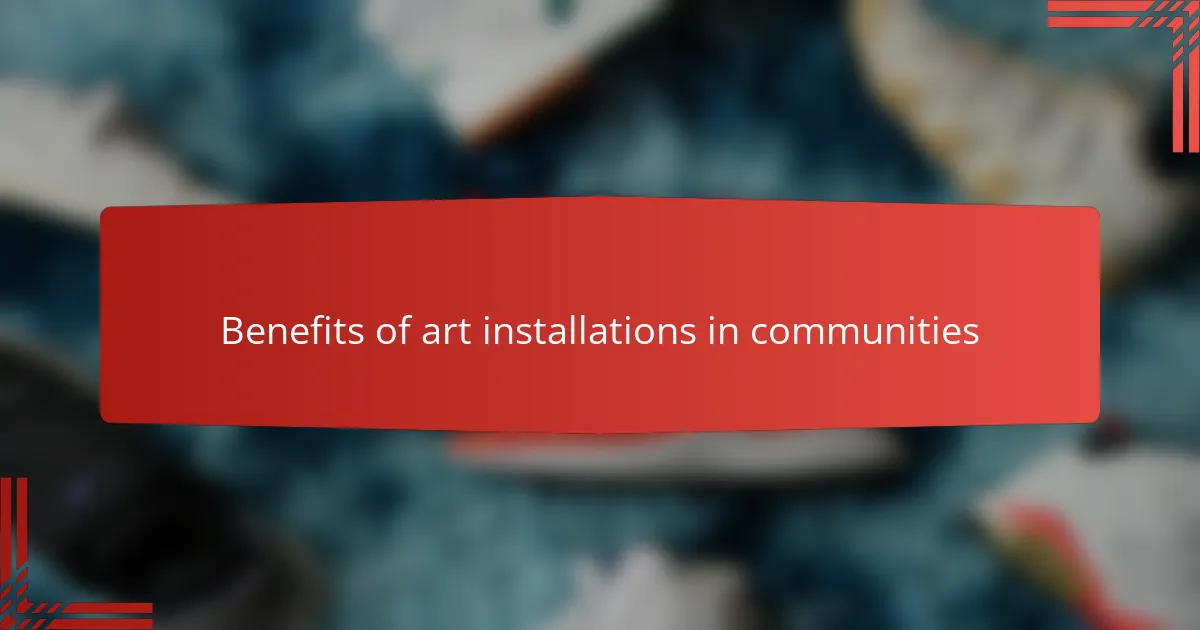
Benefits of art installations in communities
Art installations in community parks do something magical—they invite people to pause and connect, not just with the art but with each other. I’ve seen neighbors who barely exchanged hellos come together to admire a sculpture or mural, sparking conversations that might never have happened otherwise. Isn’t it amazing how a shared experience like this can quietly weave stronger bonds?
Beyond social connections, these installations breathe life into public spaces, turning ordinary parks into vibrant places of inspiration. From my perspective, art acts like a gentle nudge, encouraging us to see our environment—and ourselves—through fresh eyes. Doesn’t that shift in perception often lead to a deeper appreciation for where we live?
Lastly, art in community spaces fosters a sense of pride and ownership. When people contribute ideas or support an installation, it becomes a collective achievement. I’ve noticed how that pride can empower residents to take greater care of their neighborhood, making the park not just a backdrop, but a reflection of the community’s heart. Have you ever felt that sense of belonging that comes from creating something meaningful together?
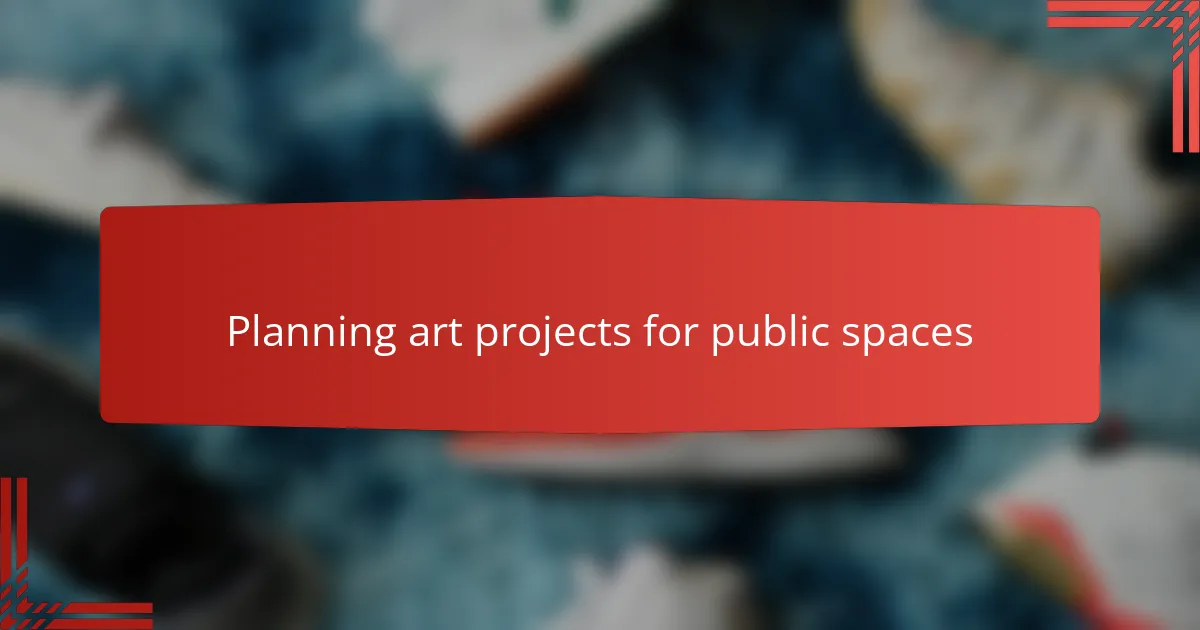
Planning art projects for public spaces
Planning art projects for public spaces always starts with listening—really tuning in to the community’s stories, needs, and dreams. I remember sitting down with local residents in Denver parks, hearing their hopes for places where their kids could play safely or where elders could find quiet reflection. Have you ever experienced how just giving people a chance to share sparks ideas that feel both personal and universal?
Budgeting and logistics often feel like a maze, but I’ve found that being upfront and flexible opens up more creative solutions than I expected. For one installation, unexpected funding cuts meant we had to rethink materials and scale, but involving community members in that problem-solving made the final result even more meaningful. Isn’t it fascinating how constraints can sometimes fuel innovation rather than limit it?
Securing permits and aligning with city regulations can be daunting, yet it also presents an opportunity to build alliances across local agencies and groups. From my experience, navigating these layers taught me patience and the importance of clear communication. How many projects gain strength from partnerships you didn’t anticipate at the outset? I’d say many, especially when the shared goal is to enrich a public space everyone values.
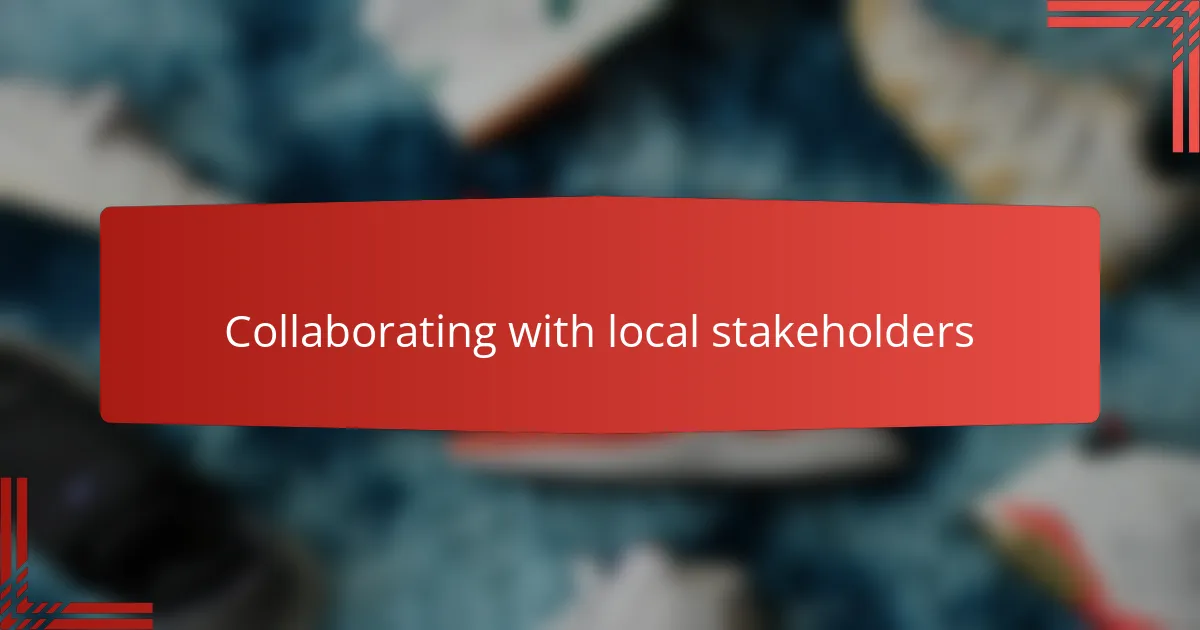
Collaborating with local stakeholders
Working closely with local stakeholders felt like weaving a tapestry of trust and shared vision. I recall one meeting with neighborhood leaders where, despite different priorities, we found common ground in the simple desire to see the park flourish. Have you ever noticed how when people feel genuinely heard, collaboration flows naturally and ideas blossom?
Engaging with city officials, community groups, and local artists taught me the art of balancing diverse perspectives. It wasn’t always easy—sometimes conflicting schedules or viewpoints threatened to stall progress—but those moments pushed me to deepen my listening and find creative compromises. Isn’t that what true collaboration is about, anyway?
What struck me most was the energy that emerged when everyone contributed, whether through funding, volunteering, or sharing stories from the neighborhood’s past. That collective ownership transformed the installations from mere decorations into living symbols of community spirit. Have you ever experienced that kind of powerful connection when people come together with a shared purpose?
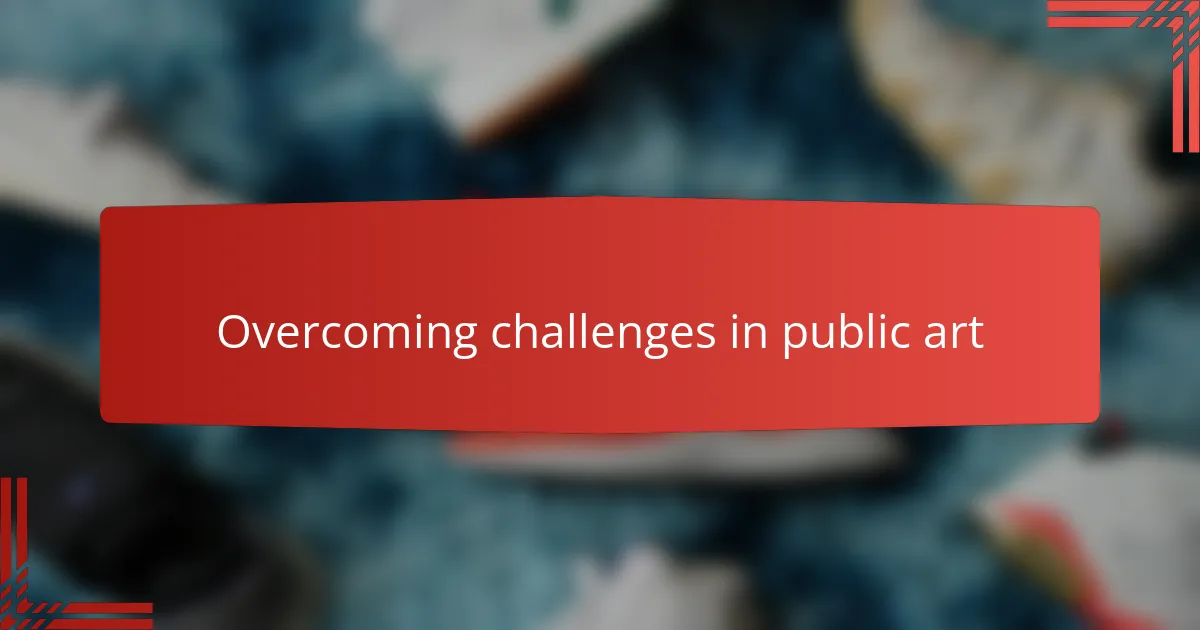
Overcoming challenges in public art
There were moments when unexpected weather or vandalism threatened to undo weeks of work, and I found myself asking, “How do we stay resilient when the setbacks seem endless?” What helped me most was leaning into the community’s spirit—neighbors showing up to help repair or protect the art reminded me why perseverance matters. Have you ever felt that surge of collective determination that turns obstacles into milestones?
Navigating differing opinions about what the art should represent was another hurdle. I learned to embrace those voices rather than avoid them, finding that honest conversations often revealed shared values beneath surface disagreements. Isn’t it interesting how tension can become fertile ground for deeper understanding and creativity when approached with care?
Sometimes, the toughest challenge was simply maintaining momentum amid limited resources and shifting priorities. Keeping everyone inspired meant celebrating small wins and reminding myself—and the team—why the project mattered beyond the physical art. Can you recall a time when a sense of purpose helped you push through fatigue or frustration? That’s the kind of drive that sustains public art’s impact.
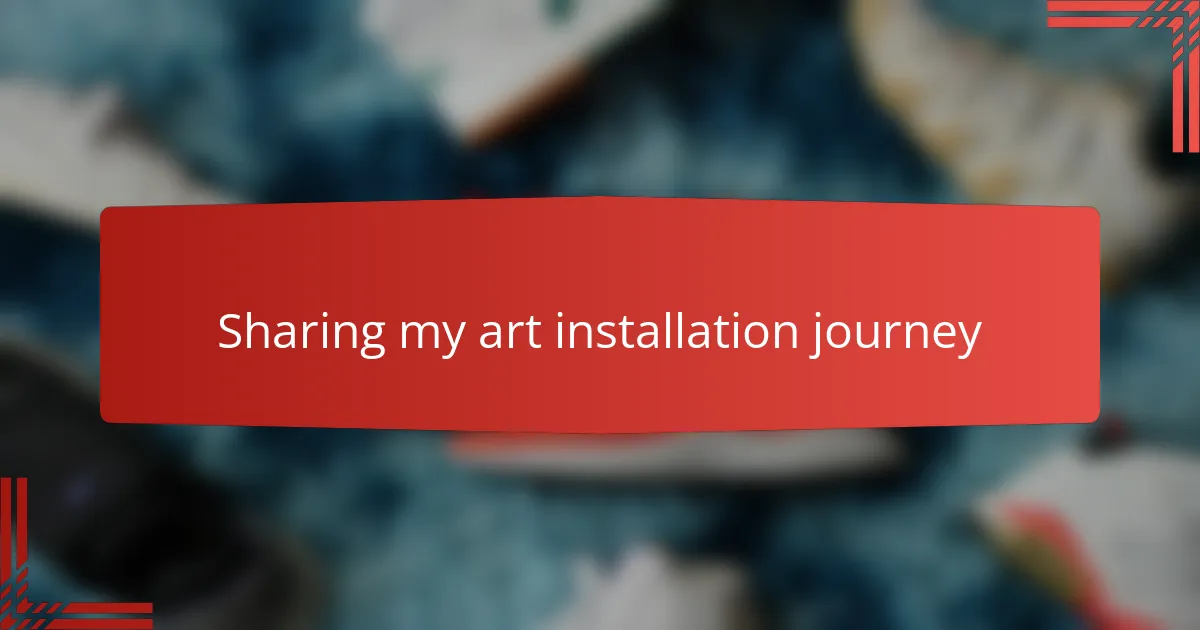
Sharing my art installation journey
Sharing my art installation journey feels like unfolding a deeply personal story, one filled with moments of inspiration, hesitation, and unexpected joy. I remember standing in a Denver park, seeing a blank space that seemed to hold endless possibilities—and wondering how my vision could truly touch the people who would gather there. Have you ever felt that mix of excitement and nervousness before bringing something new into a community space?
Throughout the process, each brushstroke and placement became more than just artistic choices; they were conversations with the neighborhood itself. I often found myself reflecting on the faces of those who stopped to watch or share their thoughts, realizing the installation was slowly becoming a shared narrative rather than my solo creation. Isn’t it remarkable how art can peel back layers and invite voices that might otherwise go unheard?
Sometimes, the journey felt like navigating through a maze with no clear end, yet those twists brought unexpected connections and growth. When setbacks came, like a storm washing away days of work or doubts creeping in, the collective spirit of the community breathed life back into the project. Have you ever witnessed how a group’s shared determination can transform frustration into fuel for creativity? That energy was what kept me going every step of the way.
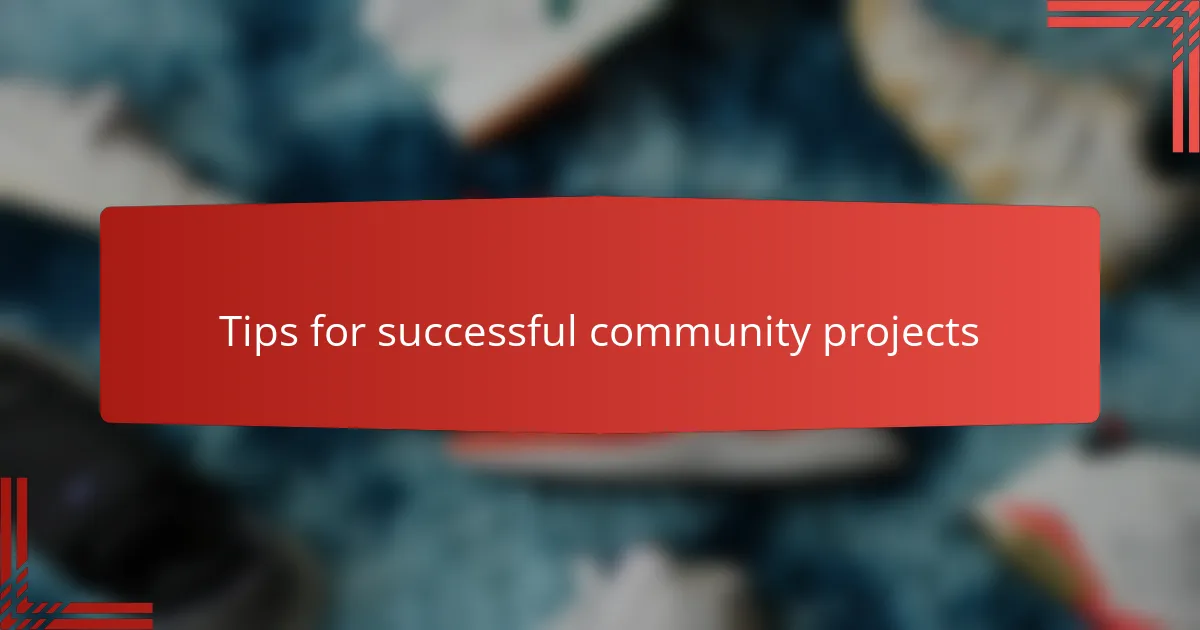
Tips for successful community projects
One tip I’ve found invaluable is to truly involve the community from the very start. When people see their ideas reflected in the project, it sparks a sense of ownership and enthusiasm that money or planning alone can’t buy. Have you noticed how a space transforms when it carries the fingerprints of diverse voices?
Flexibility is another lesson I learned the hard way. During one project, unexpected weather delays forced us to rethink our timeline and materials, which initially felt frustrating. Yet, adapting together revealed hidden strengths and creativity—what setbacks do you think could secretly invite innovation?
Lastly, celebrating even the smallest milestones keeps spirits high amid the long journey of community projects. I remember how we marked each phase with a simple gathering or shout-out, turning progress into shared joy. Doesn’t recognizing every step forward remind us why the effort matters so much?